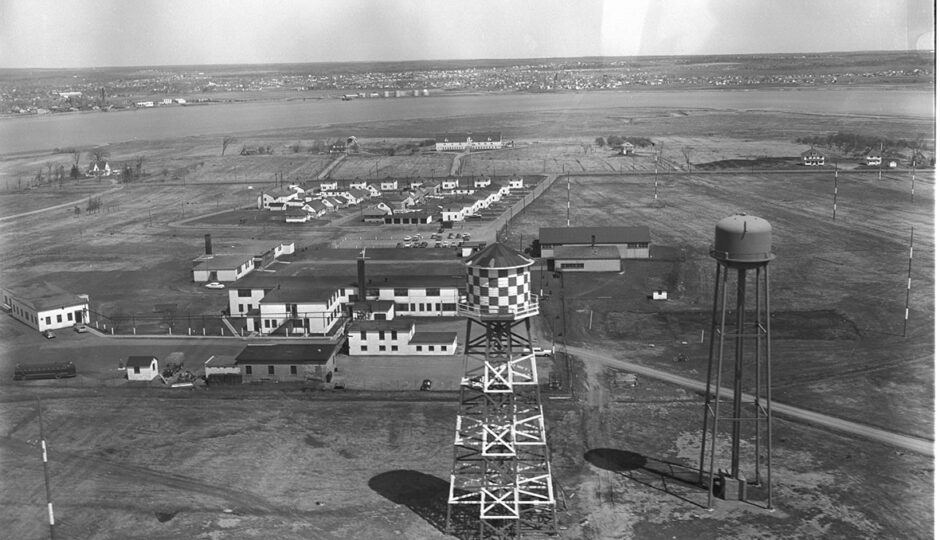
The Women’s Royal Canadian Naval Service (WRCNS) was created in 1942. Nicknamed the “Wrens,” these women served in 48 trades, including coders, visual signalers, teletype operators, switchboard and radio operators, plotters and telegraphists. The WRCNS motto was: “To free a man for service afloat.”
Wrens were not only operators but also technicians able to maintain the equipment. For those who trained to copy Morse Code, the minimum speed by the end of training was 22 wpm. Other tasks included intercepting encrypted radio messages from German U-boats on the East Coast and messages from the Japanese Navy in their version of code called Wabun or Kana Morse code on the West Coast. The Military Communications and Electronics Museum has several items in our collection from members of the WRCN including Isabel McDonald (Kana Code) and Freida Bindman (Morse Code).

CFB Kingston Base Photo
This hat on exhibit at the museum, is accredited to Frieda Bindman (married name Dougherty). Lieutenant Bindman wore this while she was the Commanding Officer (1945-1946) of HMCS Coverdale a Special Wireless Station built for Direction Finding (DF) U Boat (submarines) locations.
HMCS Coverdale was a High Frequency/Direction Finder (HF/DF) station for intercepting messages and locating U Boats. This was accomplished by intercepting Morse Code transmissions from the submarines as they radioed to headquarters in Germany and the French coast. The station was also responsible for supporting search and rescue operations for aircraft in distress.
HMCS Coverdale was located over a tremendous bog near Moncton, New Brunswick. The water provided a very good conducting surface for radio frequency signals. The station was staffed by personnel from the Women’s Royal Canadian Naval Service (WRCNS). In the early days of 1944, HMCS Coverdale was not yet complete when the Wrens moved in. Most noticeable was a lack of doors. The women wrote that there was not a door to be found anywhere – not at the entrance; not to the cabins, not even to the heads (bathrooms). The Wrens mentioned the hazards of dressing and undressing while dodging workmen. Being watch keepers, the women were disrobing any time of day or night. The intercept and DF positions were staffed by some 140 Wrens in three shifts, working 24 hours a day. Because there were three 8-hour rotating watches, there was always someone sleeping in the dorm so most activity took place in the forecastle (the community room).

From right to left: Eileen Carr, Lola Jackson, Joy Kermack, Muriel Ramsay and Lavinia (Vin) Crane.
National Archives Canada photo # PA 2041 1
On April 30, 1945, a HMCS Coverdale operator intercepted a message sent by German Admiral Karl Doenitz telling all his forces that Hitler was dead. She was the first allied person to hear the news of his death.
The Women’s Royal Canadian Naval Service (WRCNS) was disbanded on 31 August 1946. HMCS Coverdale was then staffed with men. It was finally closed in 1971.

HMCS Coverdale Government of Canada
The Mercury Shop
The Museum is taking part in the Garrison Discovery Race (GDR)! This is the perfect opportunity to explore CFB Kingston during the Garrison Discovery Expo, get to know the people and services here to support you and your family, and win some prizes! You can register here:
https://www.cafconnection.ca/Kingston/In-My-Community/Events-Activities/Garrison-Discovery-Expo.aspx
Come visit the Mercury Shop during the Discovery Race. We continue to offer medal mounting and personalized gifts, including adult and kid shirts, mugs, etc. Orders take no less than 1 week, but we suggest giving 2 weeks at least to ensure that they are completed in time.
If you have any questions about our products and services, you may contact us by email at mercuryshop@c-and-e-museum.org or by phone at 613-541-5395.
Our online store is: https://www.themercuryshop.com
Cheers,
Leala Hampel
Acting Mercury Shop Supervisor
